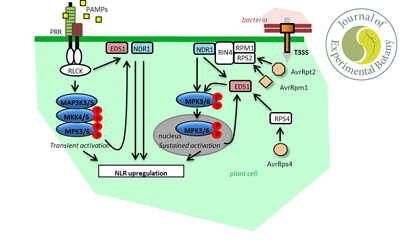MAP Kinase Signaling and integrated immune responses in plants
MAP Kinases 3 and 6 control Salicylic Acid signaling by upregulating NLR receptors during Pattern- and Effector-Triggered Immunity
The plant immune system relies on two types of receptors : the membrane-localized Pattern-Recognition Receptors that perceive Pathogen-Associated Molecular Patterns (PAMPs), thereby eliciting PAMP-Triggered Immunity (PTI), and the intracellular Nucleotide-binding Leucine-rich repeat Receptors (NLRs) that recognize pathogen effectors and implement Effector-Triggered Immunity (ETI). The characterization of specificities, similarities or crosstalks between PTI and ETI constitute one of the most exciting goal in the field of plant-microbe interactions, and is critical to better understand how plants can defend themselves against pathogens.
In a recent article published in the Journal of Experimental Botany, members of the STRESS team at IPS2 revealed that the upregulation of some NLR genes is common to both PTI and ETI, and that these upregulations can activate the plant sector of defense mediated by the hormone salicylic acid. They also showed that the immune signaling components MAP Kinases 3 and 6 (MPK3/6), the lipase-like EDS1, and the integrin-like NDR1 were involved in the NLR upregulation, although these signaling components were differentially coordinated in PTI and ETI. Overall, these findings contribute to an emerging model integrating the whole plant immune system, by supporting the notions that NLRs and ETI signaling components participate to PTI, and that MPK3/6 bridge PTI and ETI through the expression of NLR genes.

Title : The induction of NLR expression associated to PTI and ETI defense responses requires MPK3/6 activation and the ETI signaling components EDS1 and NDR1.
Mise en ligne le 03/02/2022
